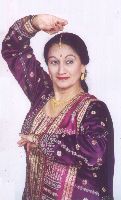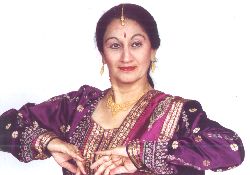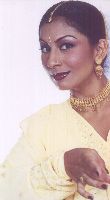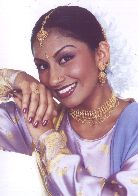
|
 |

|
 |
ANJANI AMBEGAOKAR Mar 2001  With over 20 years of intensive Kathak training under Pundit Sunderlal Gangani, Anjani Ambegaokar is the founder of the Sundar Kala Kendra Dance School, which has about 75 students and 5 branches in Los Angeles and Orange County. After doing her MA in Kathak at the MS University in Vadodara, she migrated to the USA in 1967 where she did her MBA in the Keller Graduate School of Management, Chicago. She is the recipient of several awards, including the Choreography Fellowship from California Arts Council for 2000. She was awarded the National Endowment for the Arts Choreographers Fellowship grant for 1991, 1992 to 1994, 1994 to 1996, given to only one Kathak dancer / choreographer in the USA. Apart from presenting several papers and conducting workshops, Anjani has taught Kathak at several universities including University of California, Irvine Extension and Dance Center, Columbia College. She has been invited to teach at the UC Irvine Dance Dept for Winter quarter 2001. I started learning Bharatanatyam in Vadodara at the age of three from Kubernathji Tanjorkar. It was my father's dream to teach me dance. My Guruji Pandit Sundarlaljee Gangani was invited to teach Kathak at the M. S. University of Vadodara. My cousins had started learning from Guruji and my father was impressed with his teaching, so he invited Guruji to teach me. I still remember my Guruji climbing up the stairs of our home and as a 7-year-old child I felt very happy to see him and that I would be learning dance from him. I just felt very connected to Kathak from the first day.  Once you migrated to the US, how did you continue your Kathak training that you had started under Pandit Sunderlal Gangani? I moved to USA to get married at the age of 22. I had learned from Guruji for almost 15 years. I had acquired my diploma, and BA and MA degrees from the M. S. University of Vadodara in Kathak Dance. I continued returning to India whenever possible and train with him during my stay in Vadodara. I also continued to perform for festivals in India during my visits. And to this day, I still continue to learn from Guruji. I have always felt blessed to have a Guru like him, and I firmly believe in the Guru-Shishya Parampara. How did you manage to present your initial productions in the US and how have you built up an audience for your work over the years? After I moved to USA, we (my husband and myself) lived in Chicago for 10 years from 1968 to 1978. I worked in accounting, filed with my degree in Economics and did Kathak part time for about 6 years. I started performing in small venues, Indian functions, and toured the elementary schools and high schools circuits. As the word spread I was invited to teach at the Dance Center of the Columbia College, which was very helpful for my career. I was selected to tour with the National Endowment for the Arts touring program and also received some grants for choreography from Illinois Arts Council. I toured as soloist with musicians (local that I had to work with) in the Midwest, mostly universities and colleges and slowly the audience developed. We moved to Los Angeles in 1978 and Amrapali was born the same year in Chicago. In Los Angeles, I performed for two major events, the UCLA International Festival and Music Circle in 1979. I was fortunate to have Zakir Bhai (Zakir Hussain) on Tabla for the Festival, and for some other performances during the next few years such as Redlands Bowl Summer Festival, Claremont Colleges, Orange Coast College and a performance in Vadodara also. I found Los Angeles a more welcoming city for Indian classical dance than Chicago. I established the Sundar Kala Kendra Foundation (named after my guruji) a non - profit umbrella organization for my dance school and my dance company, Anjani's Kathak Dance of India. I was selected to be part of the California Arts council touring program and received several grants from the Arts Council, as a soloist and later as a dance company. I trained my students to be part of my dance company and I still do. You have to work at developing audiences in your own city and also on tour. For example when we tour a small university town such as Pocatello, Idaho, I tell the presenter to locate some Indian family in the town, then I establish contact with them and request them to bring their families and friends for these ticketed performances. The educational aspect of the tour is very important for me, such as performances in elementary schools and high schools during the day, where children tell their parents to see the evening programs, lecture demonstrations / master classes for the dance and music department, during the day, and the students get interested and come to see the evening performances, another way of developing audiences. These are called residencies, which are very helpful for an overall enriching experience of the art form. I have developed a session about mathematics and Kathak rhythms, including algebraic equations of Rela in a Tatkar with the help of my husband. These sessions are usually presented for the students of science at a university. This is one more activity of developing the audience and reaching out to new venues. In the 70's and 80's, whenever Indian dance was staged in the US, it was combined with ethnic dance from other countries, mostly folk dances. Has it changed now for the better and has the terminology changed? It is still considered as ethnic dance at many venues by the presenters. For some venues at major universities and major festivals and performing arts centers, it is in the category of World Dance and / or traditional dance, which can also include a large folk dance group from Russia. The funding of the National Endowment For the Arts, can include Indian dance in dance category and / or it can be part of the Folk and Traditional arts category. The California Art council funding has the same format. Our foundation just received a grant from the folk and traditional arts program. Because of funding problems, many who love to do traditional dance are forced to collaborate with others. This is forcing the pure nature of thestyle to be threatened. Not everyone's suited to doing collaborative work. So, what happens to the original form of classical dance, which is essentially taught as a solo tradition? No artist should be forced to do any work that he or she may not want to,just for the funding, it will not work. Collaborations have to come from the heart, and the artists have to be passionate and excited about the whole process, otherwise the presentation will have many flaws and the audience can feel the negative energy in the performance. As far as the funding is concerned, you do not have to collaborate in order to receive funding, the artistic excellence matters more than any collaboration. You can continue as a solo traditional artist and still receive funding. Of course you have to work at it. I do not think that the pure nature of the dance style is threatened by collaborating with other dance forms. My experience is, it helps you to look deeper into your dance form, grow as an artist and appreciate your own dance form and other dance forms with lot more humility and respect. How satisfying are your artistic collaborations in the US? What about thefinancial aspect of these collaborations? My artistic collaborations are very satisfying in the USA. As always I feel that we can do better the next time and continue to improve on the work that we have already presented. I have been fortunate to receive funding from presenting organizations for all my collaborations. I had to work at making proposal for a collaboration, with several follow up meetings, to persuade a presenter to take on the project, such as the Los Angeles Festival at the Wardsworth Theatre for one collaboration and the Cerritos Center for the performing Arts for the past two collaborations. Through these collaborations, how much of a new dance style do you learn? For instance, in 'Soul to Sole' that features Kathak, tap and flamenco.... I do not think you learn a new dance style in such a short time of 6-8months. In the 'Soul to Sole' that featured Kathak, Tap and Flamenco, us three artistic directors / choreographers had decided that we will not tryto copy each others forms, but to try to create new terminology, or come up with existing terminology suited to a specific piece that we were working on. What I think you learn in a collaboration such as this is thesimilarities and differences, beauty, grace, subtle nuances uniqueness of the movements and rhythmic intricacies of each dance form and how achoreographer approaches his or her dance style. For example in a duet of Amrapali and Steve Zee of Kathak and Tap, I introduced Zaptal of 10 beats,and requested Steve to interpret the complexity of Zaptal rhythm that Amrapali was doing, in his own version in Tap style. When I performed theSwing rhythm of Jazz and Tap, then I worked my Kathak terminology that suited the Swing beat and it worked very well. Today, the audience wants virtuosity, excitement, entertainment, artisticability.... they want everything in every performance. So, there's a blending of styles to meet this demand. This is the case in India. How is it in the US? I think that the younger generation of Indian dancers here in the USA arelooking forward to the blending of the styles more than our generation. Thenew generation wants to learn more than their own classical Indian style and create a new genre of movements that would bring out the best of each style.I think it is risky, but I do not think there is any stopping to this process. I think the virtuosity and artistic ability of the dancer can beseen in any one style with the excellence of her work, and that there is still so much to explore in our own dance forms that we are learningsomething new each day. As far as audience excitement and entertainment is concerned, it is up to each individual artist to cater to that need as tohow he or she finds it fit for their work. Besides the collaboration, I havealways sought to expand on my work and push the boundaries in many other new works that we present here. In 1972, I created a new work to 'Shaft' musicin Kathak style. Since then I have done a full length work 'Ma Aur Betiyan' in 1990 about a first and second generation of Indian mother and daughters growing up in the USA, a group piece titled World Music and Kathak Rhythms including music of U2 and Gypsy Kings, a group piece to 'My Heart Will Go On' from Titanic, without Ghungroo and contemporary costumes, to 'Desert Rose' by Sting also without Ghungroo and contemporary costumes. I felt that I could expand on some movements very differently without Ghungroo andreduce the dependency on rhythmic aspect, I loved doing it. How are Kathak and Bharatanatyam viewed in the California Arts Councils? Both dance forms are viewed positively by the Arts council. It is more about the work of the artist than the form that the Arts council is concerned about. Can you comment on the competition among the many Indian dancers based in California? If I look at the map of California it has a lot of land and places for Indian dancers to nurture their dance styles. Each dancer can find their own place on the map of California, artistically. We are all very differently trained and our outlook is quite different from each other as to how we want to pursue our dream of carrying on our classical traditions. Some dancers are into teaching only, some are into performing only, some are doing teaching, performing and choreography and every one is doing well. There is always healthy competition, which is necessary for all of us to grow and respect each other's work and be curious about it. We all attend each other's performances whenever possible and call each other with positive comments, and we have collaborated with each other's dance styles several times. I have made friendship with some of the dancers, and it is very important for me to have such friendship and to share views and ideas. We have excellent classical dancers in California. How important is it for an artiste to have a manager to take over management worries? If you can find a person who wants to manage your dance company and dance school, who is passionate about your work and understands your needs, then you have it made. It is very hard to find someone who fits that description. I have always managed my dance company, it is a lot of work and it is not easy. I think it is very important here in the USA to have a manager to manage your work.   I think it is very important for a dancer's son / daughter to carry on the dance tradition. It may or may not happen as you imagine and plan. With my daughter Amrapali I started teaching her at the early age of 4, but did not pursue teaching her individually until she was about 10 years old. Till then she used to dance with other students of the dance school and always liked performing. I saw a piece that she did and I felt that she was ready to learn seriously at that time when she was 10 years old. Since then there has never been any looking back, she has toured extensively with the dance company, as a soloist, she has also performed in India with me on several tours from Chennai to Lucknow. She has also been my confidante, friend,assistant, in the field of dance and always came up with new idea for us to grow as artists. She has joined Cirque Du Soleil for a two year contract as a dancer and likes it a lot. I do not know what the future holds for us as far as her carrying on the tradition of Kathak!!!!!! Anjani Ambegaokar, Amrapali Ambegaokar "Sundar Kala Kendra Dance School" 1934, Peaceful Hills Road Diamond Bar, CA 91765 Ph: (909) - 595-8934 Fax: (909) - 598-3351 e-mail: AnjaniA@aol.com amrapali@iam.com Nrtyangana@aol.com |